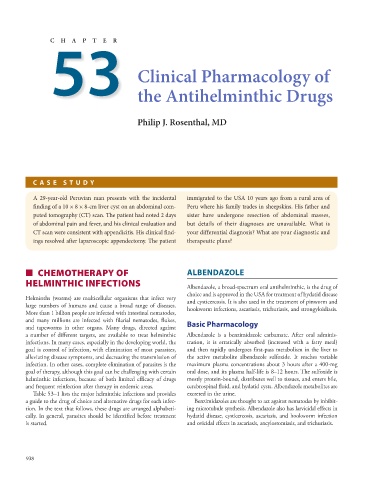Page 952 - Basic _ Clinical Pharmacology ( PDFDrive )
P. 952
53 Clinical Pharmacology of
C H A P T E R
the Antihelminthic Drugs
Philip J. Rosenthal, MD
C ASE STUD Y
A 29-year-old Peruvian man presents with the incidental immigrated to the USA 10 years ago from a rural area of
finding of a 10 × 8 × 8-cm liver cyst on an abdominal com- Peru where his family trades in sheepskins. His father and
puted tomography (CT) scan. The patient had noted 2 days sister have undergone resection of abdominal masses,
of abdominal pain and fever, and his clinical evaluation and but details of their diagnoses are unavailable. What is
CT scan were consistent with appendicitis. His clinical find- your differential diagnosis? What are your diagnostic and
ings resolved after laparoscopic appendectomy. The patient therapeutic plans?
■ CHEMOTHERAPY OF ALBENDAZOLE
HELMINTHIC INFECTIONS Albendazole, a broad-spectrum oral antihelminthic, is the drug of
choice and is approved in the USA for treatment of hydatid disease
Helminths (worms) are multicellular organisms that infect very and cysticercosis. It is also used in the treatment of pinworm and
large numbers of humans and cause a broad range of diseases. hookworm infections, ascariasis, trichuriasis, and strongyloidiasis.
More than 1 billion people are infected with intestinal nematodes,
and many millions are infected with filarial nematodes, flukes, Basic Pharmacology
and tapeworms in other organs. Many drugs, directed against
a number of different targets, are available to treat helminthic Albendazole is a benzimidazole carbamate. After oral adminis-
infections. In many cases, especially in the developing world, the tration, it is erratically absorbed (increased with a fatty meal)
goal is control of infection, with elimination of most parasites, and then rapidly undergoes first-pass metabolism in the liver to
alleviating disease symptoms, and decreasing the transmission of the active metabolite albendazole sulfoxide. It reaches variable
infection. In other cases, complete elimination of parasites is the maximum plasma concentrations about 3 hours after a 400-mg
goal of therapy, although this goal can be challenging with certain oral dose, and its plasma half-life is 8–12 hours. The sulfoxide is
helminthic infections, because of both limited efficacy of drugs mostly protein-bound, distributes well to tissues, and enters bile,
and frequent reinfection after therapy in endemic areas. cerebrospinal fluid, and hydatid cysts. Albendazole metabolites are
Table 53–1 lists the major helminthic infections and provides excreted in the urine.
a guide to the drug of choice and alternative drugs for each infec- Benzimidazoles are thought to act against nematodes by inhibit-
tion. In the text that follows, these drugs are arranged alphabeti- ing microtubule synthesis. Albendazole also has larvicidal effects in
cally. In general, parasites should be identified before treatment hydatid disease, cysticercosis, ascariasis, and hookworm infection
is started. and ovicidal effects in ascariasis, ancylostomiasis, and trichuriasis.
938

